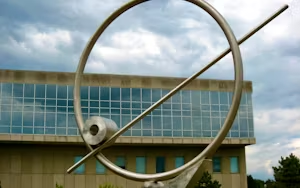SAT scores needed to get into Ball State University
Average Score and SAT Requirements
Average SAT Score 1165
The average composite SAT score for admitted Ball State University freshman is 1165 out of 1600. For perspective, a 1165 is in the 71st percentile of all SAT test takers.
SAT Score Range 1080 to 1250
The middle fifty percent of incoming students have SAT composite scores ranging from 1080 to 1250. The 75th percentile score is 1250 while the 25th percentile score is 1080.
Minimum SAT score requirement
The lowest SAT score accepted is not reported by BSU but we estimate it to be around a 990 total composite SAT score.
Average SAT Math Score 575
The average score for BSU students on the math portion of the SAT is 575 out of 800. The 25th percentile of students score a 530 and the 75th percentile score 620.
Average SAT Reading Score 590
The 25th and 75th percentile range for SAT reading scores range from 550 to 630 and the average score for Ball State University students is 590.
Number of Students Submitting SAT Scores
32 percent of students submit SAT scores with their application to Ball State UniversityAdmission Chances by SAT Score
Below are estimated chances of being accepted at Ball State University based on SAT score ranges and the overall admission rate of 71.6%. These chances assume you have an average GPA for the school, around 3.52.
Can I get into BSU with a 1250 SAT?
- Score competitiveness Very Good
An SAT score of 1250 or higher is very competitive at BSU and is a better score than three quarters of students who are accepted. You have a very good chance of acceptance, around 83% or higher.
Can I get into BSU with a 1170 SAT?
- Score competitiveness Above Average
Scores between 1170 to 1240 are above average giving you an advantage over most applicants. Your chance of acceptance is very high, estimated about 73% to 82%.
Can I get into BSU with a 1080 SAT?
- Score competitiveness Below Average
SAT scores between 1080 to 1160 are still in the middle range of accepted students a but a little lower than the average. You can get in and have about a 58% to 71% percent chance of being admitted.
Can I get into BSU with a 990 SAT?
- Score competitiveness Reach
SAT scores from 990 to 1070 are on the very low end of the range where students are accepted. Scores in this range are not competitive with most other applicants but you still have a chance. We estimate scores in this range have less than a 56% chance of admission to BSU. SAT scores below 990 likely fall out of the range where students are regularly accepted.
Data Sources, IPEDS for Fall 2023 starting class| SAT Score | Admission Chances |
|---|---|
| 1600 | 99% |
| 1590 | 98% |
| 1580 | 98% |
| 1570 | 98% |
| 1560 | 98% |
| 1550 | 98% |
| 1540 | 98% |
| 1530 | 98% |
| 1520 | 97% |
| 1510 | 97% |
| 1500 | 97% |
| 1490 | 97% |
| 1480 | 97% |
| 1470 | 96% |
| 1460 | 96% |
| 1450 | 96% |
| 1440 | 95% |
| 1430 | 95% |
| 1420 | 95% |
| 1410 | 94% |
| 1400 | 94% |
| 1390 | 93% |
| 1380 | 93% |
| 1370 | 92% |
| 1360 | 92% |
| 1350 | 91% |
| 1340 | 91% |
| 1330 | 90% |
| 1320 | 89% |
| 1310 | 88% |
| 1300 | 88% |
| 1290 | 87% |
| 1280 | 86% |
| 1270 | 85% |
| 1260 | 84% |
| 1250 | 83% |
| 1240 | 82% |
| 1230 | 81% |
| 1220 | 80% |
| 1210 | 78% |
| 1200 | 77% |
| 1190 | 76% |
| 1180 | 74% |
| 1170 | 73% |
| 1160 | 71% |
| 1150 | 70% |
| 1140 | 68% |
| 1130 | 66% |
| 1120 | 65% |
| 1110 | 63% |
| 1100 | 61% |
| 1090 | 59% |
| 1080 | 58% |
| 1070 | 56% |
| 1060 | 54% |
| 1050 | 52% |
| 1040 | 50% |
| 1030 | 48% |
| 1020 | 46% |
| 1010 | 44% |
| 1000 | 43% |
Similar Colleges
Purdue University North Central Campus
Public 4 Year
Indiana University Bloomington
Public 4 Year
Purdue University Main Campus
Public 4 Year
Indiana State University
Public 4 Year
Indiana University Northwest
Public 4 Year
Indiana University Purdue University Fort Wayne
Public 4 Year
Ohio University Main Campus
Public 4 Year
Kent State University at Kent
Public 4 Year
Grand Valley State University
Public 4 Year
Earlham College
Private 4 Year
Northern Kentucky University
Public 4 Year
Purdue University Calumet Campus
Public 4 Year
Murray State University
Public 4 Year
University of Southern Indiana
Public 4 Year
Wright State University Main Campus
Public 4 Year
University of Notre Dame
Private 4 Year
University of Toledo
Public 4 Year
University of Indianapolis
Private 4 Year
Butler University
Private 4 Year
Primary data source, U.S. Department of Education https://nces.ed.gov/collegenavigator/?id=150136 IPEDS survey data for Ball State University.


















